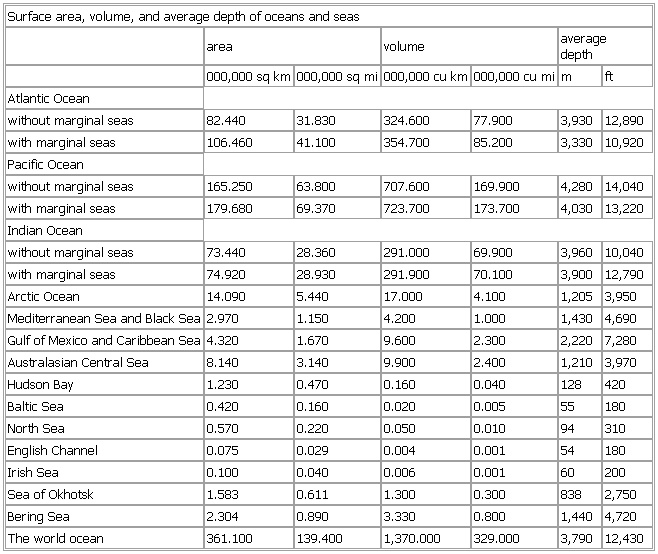- Surface area, volume, and average depth of oceans and seas
-
▪ TableSurface area, volume, and average depth of oceans and seasarea volume average depth000,000 sq km 000,000 sq mi 000,000 cu km 000,000 cu mi m ftAtlantic Oceanwithout marginal seas 82.440 31.830 324.600 77.900 3,930 12,890with marginal seas 106.460 41.100 354.700 85.200 3,330 10,920Pacific Oceanwithout marginal seas 165.250 63.800 707.600 169.900 4,280 14,040with marginal seas 179.680 69.370 723.700 173.700 4,030 13,220Indian Oceanwithout marginal seas 73.440 28.360 291.000 69.900 3,960 10,040with marginal seas 74.920 28.930 291.900 70.100 3,900 12,790Arctic Ocean 14.090 5.440 17.000 4.100 1,205 3,950Mediterranean Sea and Black Sea 2.970 1.150 4.200 1.000 1,430 4,690Gulf of Mexico and Caribbean Sea 4.320 1.670 9.600 2.300 2,220 7,280Australasian Central Sea 8.140 3.140 9.900 2.400 1,210 3,970Hudson Bay 1.230 0.470 0.160 0.040 128 420Baltic Sea 0.420 0.160 0.020 0.005 55 180North Sea 0.570 0.220 0.050 0.010 94 310English Channel 0.075 0.029 0.004 0.001 54 180Irish Sea 0.100 0.040 0.006 0.001 60 200Sea of Okhotsk 1.583 0.611 1.300 0.300 838 2,750Bering Sea 2.304 0.890 3.330 0.800 1,440 4,720The world ocean 361.100 139.400 1,370.000 329.000 3,790 12,430See as table:

* * *
Universalium. 2010.
